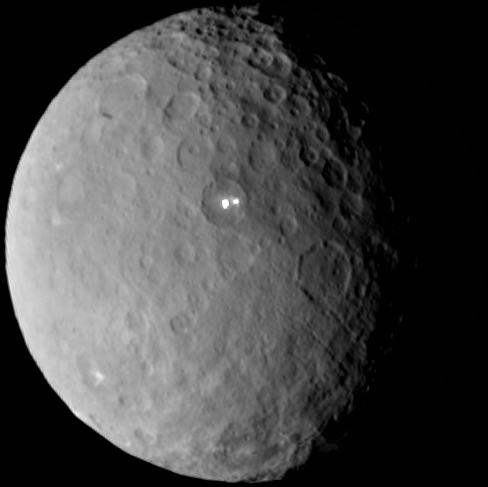
6th March 2015 NASA's Dawn probe arrives at Ceres NASA's Dawn probe has begun to orbit Ceres, becoming the first spacecraft to visit a dwarf planet.
Another entry on our timeline became a reality today, as the Dawn probe successfully entered orbit around Ceres – the largest and most massive object in the asteroid belt. Launched in September 2007, Dawn has travelled 3.1 billion miles (4.9 billion km) through the Solar System and is the first NASA exploratory mission to use ion propulsion to enter orbits. Today at 5:36 a.m. PST (8:36 a.m. EST / 13:36 p.m. GMT), mission controllers received a signal from the craft, indicating that Dawn was fully functional and had reached its destination as planned. Dawn is currently 38,000 miles (61,000 km) from Ceres, equivalent to about 10% of the distance between the Earth and Moon. In the coming months, however, it will perform a series of manoeuvres taking it much closer. After circling in a polar orbit of 8,400 miles (13,500 km), it will gradually spiral down to lower and lower altitudes, reaching 233 miles (375 km) in November 2015. This will enable very high resolution photos of the surface to be obtained, while vast amounts of data from a gamma-ray and neutron detector (GRaND) will reveal the internal structure and composition. These measurements could provide new clues about the origin and formation of the Solar System, complementing the information gained from an earlier encounter with Vesta (the second largest asteroid) in 2011-12. "Both Ceres and Vesta, we believe, are proto-planets," said Dr Carol Raymond, deputy principal investigator, in a BBC interview. "They were on their way to forming larger planetary embryos and they were the type of object that merged to form the terrestrial planets. But these two stopped before they reached that evolutionary stage, and so they are essentially these intact 'time capsules' from the very beginning of our Solar System; and that's really the motivation for why Dawn is going there to explore them in detail." Last year, plumes of water vapour were detected from Ceres using the Herschel Space Observatory, and scientists now believe this dwarf planet may contain a thick mantle of ice. This may explain the two bright "spots" which can be seen inside a crater in the northern hemisphere. There is speculation that a recent impact may have exposed this buried layer, vaporising the ice and leaving behind very reflective salts. "We feel exhilarated," said Chris Russell, principal investigator of the Dawn mission at the University of California, Los Angeles (UCLA). "We have much to do over the next year and a half, but we are now on station with ample reserves, and a robust plan to obtain our science objectives." You can follow the latest updates on Twitter and the mission page of the NASA website.
Comments »
|







